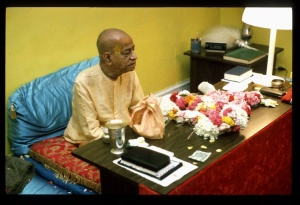CC Madhya 21.104 (1975)

A.C. Bhaktivedanta Swami Prabhupada
Below is the 1996 edition text, ready to be substituted with the 1975 one using the compile form.
TEXT 104
- rūpa dekhi’ āpanāra, kṛṣṇera haila camatkāra,
- āsvādite mane uṭhe kāma
- ’sva-saubhāgya’ yāṅra nāma, saundaryādi-guṇa-grāma,
- ei-rūpa nitya tāra dhāma
SYNONYMS
rūpa dekhi’—by seeing the form; āpanāra—His own; kṛṣṇera—of Lord Kṛṣṇa; haila—there was; camatkāra—wonder; āsvādite—to taste; mane—in the mind; uṭhe—arises; kāma—a desire; sva-saubhāgya—one’s own good fortune; yāṅra—of which; nāma—the name; saundarya-ādi-guṇa-grāma—the transcendental qualities, headed by beauty; ei rūpa—this form; nitya—eternal; tāra—of them; dhāma—the abode.
TRANSLATION
“The wonderful form of Kṛṣṇa in His personal feature is so great that it attracts even Kṛṣṇa to taste His own association. Indeed, Kṛṣṇa becomes very eager to taste it. Total beauty, knowledge, wealth, strength, fame and renunciation are the six opulences of Kṛṣṇa. He is eternally situated in His opulences.
PURPORT
Kṛṣṇa has many pastimes, of which His pastimes in Goloka Vṛndāvana (the gokula-līlā) are supreme. He also has pastimes in the Vaikuṇṭhas, the spiritual world, as Vāsudeva, Saṅkarṣaṇa, Pradyumna and Aniruddha. In His pastimes in the spiritual sky, He lies down in the Causal Ocean as Kāraṇārṇavaśāyī, the puruṣa-avatāra. His incarnations as a fish, tortoise and so on are called His causal incarnations. He incarnates in the modes of nature as Lord Brahmā, Lord Śiva and Lord Viṣṇu. He also incarnates as empowered living entities like Pṛthu and Vyāsa. The Supersoul is His localized incarnation, and His all-pervasive aspect is the impersonal Brahman.
When we consider impartially all the unlimited pastimes of the Lord, we find that His pastimes as a human being on this planet—wherein He sports as a cowherd boy with a flute in His hands and appears youthful and fresh like a ballet dancer—are pastimes and features that are never subjected to material laws and inebrieties. The wonderful beauty of Kṛṣṇa is presented in the supreme planet, Gokula (Goloka Vṛndāvana). Inferior to that is His representation in the spiritual sky, and inferior to that is His representation in the external energy (Devī-dhāma). A mere drop of Kṛṣṇa’s sweetness can drown these three worlds—Goloka Vṛndāvana, Hari-dhāma (Vaikuṇṭhaloka) and Devī-dhāma (the material world). Everywhere, Kṛṣṇa’s beauty merges everyone in the ecstasy of transcendental bliss. Actually the activities of yogamāyā are absent in the spiritual sky and the Vaikuṇṭha planets. She simply works in the supreme planet, Goloka Vṛndāvana, and she works to manifest the activities of Kṛṣṇa when He descends to the material universe to please His innumerable devotees within the material world. Thus a replica of the Goloka Vṛndāvana planet and the pastimes there is manifested on this planet on a specific tract of land—Bhauma Vṛndāvana, the Vṛndāvana-dhāma on this planet.